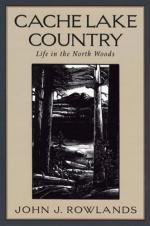
|
| Name: _________________________ | Period: ___________________ |
This test consists of 15 multiple choice questions and 5 short answer questions.
Multiple Choice Questions
1. Cree Indians viewed the Big Dipper (part of Ursa Major) as the Great Bear constellation, and the three stars in the handle as what?
(a) Cubs.
(b) Paw tracks.
(c) Hunters.
(d) Beehives.
2. What trees in the swamps sheltered the deer and moose during the winter?
(a) Cedar and oak.
(b) Black spruce and birch.
(c) Cedar and black spruce.
(d) Yellow pine and oak.
3. Diagrams and discussion reflected which four tools as those essential for wood-carving?
(a) The handsaw, razor, rasp, and file.
(b) The coping saw, knife, rasp, and file.
(c) The bandsaw, knife, rasp, and hammer.
(d) The coping saw, knife, sander, and razor.
4. What was taught as the proper way to land a canoe ashore?
(a) Get out in the water to lift the bow ashore.
(b) Stern on.
(c) Broadside.
(d) Bow on.
5. The stars on February nights were compared with sparkling jewels of what color on a black background?
(a) Gold.
(b) Blue-white.
(c) Silver.
(d) Pure white.
6. The Indian paddle stroke Chief Tibeash used was short, began at the waist, and ended with a thrust from what point?
(a) The shoulders.
(b) The cross arm.
(c) The wrists.
(d) The biceps.
7. Jim viewed frogs to be good for what?
(a) Eating annoying insects.
(b) Providing comfort in their croaks.
(c) Fish bait.
(d) Proving yummy frogs legs.
8. The millions of birds that traveled faced a big problem in keeping fed, and accounts for why most stayed where relative to the front tide line?
(a) East.
(b) Ahead.
(c) West.
(d) Behind.
9. How many northern lakes had author John J. "Jim" Rowlands said he had seen when he happened upon Cache Lake?
(a) Dozens.
(b) Thousands.
(c) Hundreds.
(d) Millions.
10. What were noted as the keys to surviving in the wilderness, finding one's way about, and avoiding possible dangers?
(a) Observing things closely and watching the sun.
(b) Learn from those before you and simply apply the lessons.
(c) Always bring a compass and extra food.
(d) Common sense and observing everything closely.
11. What was suggested as the first step to dry moccasins?
(a) Rub them with moose fat.
(b) Stuff them with bent birch twigs.
(c) Scrape out the moisture.
(d) Place them near the stove.
12. Jim had observed too many woodsmen suffering from what, to know that one could not abuse one's stomach without paying a price?
(a) "Bursting in the belly."
(b) "Storming in the stomach."
(c) "Gale in the gut."
(d) "Misery in the innards."
13. Jim obtained the speeds for a wind gauge he built when he tested it in what manner?
(a) Against a wind gauge at an airport.
(b) Against a wind gauge at a high school science lab.
(c) Against a wind gauge at a forest station.
(d) Against a car speedometer when held out the window.
14. Along the edge of Cache Lake to the south grew alder side by side with fish-net willows and what else?
(a) High bush blueberries.
(b) Low vine raspberries.
(c) High bush cranberries.
(d) Wild strawberries.
15. Mal de raquette was another term for what?
(a) Snowshoe lameness.
(b) Sprained ankle.
(c) Snow ski pain.
(d) Frostbite of the foot.
Short Answer Questions
1. Beyond wire springs, a diagram of one way a leather camp bellows could be made indicated what might be used to keep them expanded?
2. After owls have gulped their food down whole and it has digested, what was the next step for bones and fur?
3. What did the term "cache" mean?
4. How was dynamite used to break up a log jam?
5. What was the term used when the early morning mist that hung over the lake was referred to?
|
This section contains 657 words (approx. 3 pages at 300 words per page) |

|




